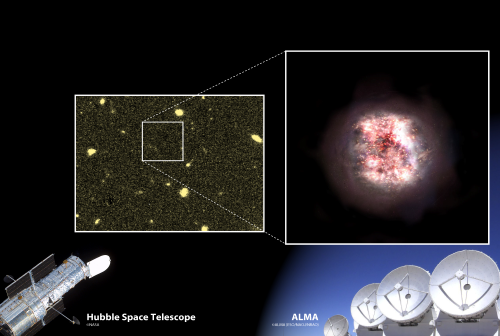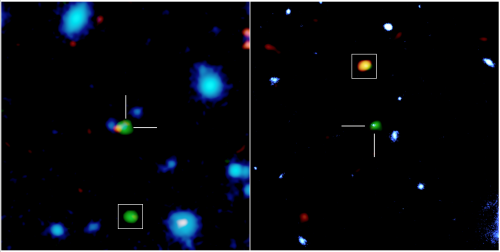Abstract
While investigating new data of young, extremely distant galaxies observed with the Atacama Large Millimeter/submillimeter Array in Chile, astronomers noticed unexpected emissions coming from seemingly empty regions in space. The global research collaboration called REBELS, where Hiroshima University Assistant Professor Hanae Inami is a co-principal investigator, discovered the radiation was emitted billions of years ago and actually came from two previously invisible galaxies entirely hidden by clouds of cosmic dust. This discovery suggests that numerous such galaxies might still be hidden in the early Universe, many more than researchers expected. The results of this work were published in the journal Nature.
A schematic of the results of this research. In a sensitive image taken by the Hubble Space Telescope (left), a region of space looks empty. However, ALMA has now revealed a previously undiscovered galaxy as it was buried deep in clouds of gas and dust. An artist’s impression of the galaxy is shown on the right. Credit: ALMA (ESO/NAOJ/NRAO), NASA/ESA Hubble Space Telescope
When astronomers peer deep into the night sky, they observe what the Universe looked like a long time ago. Because light travels at a cosmic snail’s pace, images of the most distant observable galaxies provide us a glimpse of billions of years into the past when the Universe was very young and galaxies had just started to form stars. Studying galaxies in the early Universe is one of the current frontiers in astronomy.
“It is essential for understanding the building blocks of the Universe,” Inami said.
“And our project is observing a large number of galaxies in the early Universe, trying to peep into galaxies in the first billion years of cosmic history.”
In the ongoing Reionization-Era Bright Emission Line Survey (REBELS) program, astronomers use the Atacama Large Millimeter/submillimeter Array’s (ALMA) unique capabilities to study distant galaxies at wavelengths of roughly a millimeter. A key goal is to measure how fast young galaxies grow by forming new stars.
The REBELS team observed 40 distant galaxies at a time when the Universe was only 5% of its current age. While analyzing the two galaxies’ images, the astronomers noticed strong, mysterious emissions at millimeter wavelengths far from the intended targets. To their surprise, the extremely sensitive Hubble Space Telescope, which probes the sky at shorter visible wavelengths, could not see anything at these locations.
To understand the rogue signals, the REBELS researchers investigated matters further. Detailed analyses of the signals showed that these were separate galaxies bursting with stars that had been completely overlooked.
“These new galaxies were missed not because they are extremely rare, but only because they are completely dust-obscured,” lead author Dr. Yoshinobu Fudamoto of Waseda University and the National Astronomical Observatory of Japan explained.
ALMA solved the puzzle because it can directly detect the emission of dust and carbon atoms in the gas surrounding the galaxies at millimeter wavelengths. One of the galaxies represents the most distant dust-obscured galaxy discovered so far.
What is surprising about this accidental finding is that the newly discovered galaxies, which existed 13 billion years ago, are similar to galaxies known to exist later. However, it was unexpected to find such dust-enshrouded galaxies this early, less than 1 billion years after the Big Bang.
Cosmic dust is produced in aged stars and needs time to build up to high levels and spread to hide galaxies. This soot is a kind of cosmic air pollution, where we can’t see the stars anymore due to thick smog.
“This discovery reminded me of one of the best parts of science — finding a new mystery while trying to solve another,” Inami, who was excited with this finding, said.
Despite the requirement of needing old stars to create cosmic dust, “Somehow, dust already existed at such an early stage of the Universe, and we still don’t have a clear answer why or how. There are still many exciting uncharted areas to be explored in our immense Universe," Inami added.
The current results call for more extensive searches with ALMA to find out how typical galaxies like these are. Inami leads one of the follow-up observations with ALMA for REBELS to further characterize cosmic dust in the early Universe. The imminent launch of the James Webb Space Telescope (JWST) in December 2021 and its strong synergy with ALMA will lead to especially significant advances in this field in the coming years.
“Completing our census of early galaxies with the currently missing dust-obscured galaxies, like the ones we found this time, will be one of the main objectives of JWST and ALMA surveys in the near future,” stated Professor Pascal Oesch from the University of Geneva in Switzerland.
Overall, this study constitutes an important step in uncovering the true nature and history of the early Universe, which in turn will help us understand where we are standing today.
Distant galaxies as seen with ALMA, the Hubble Space Telescope, and the European Southern Observatory’s VISTA telescope. The two galaxies in the crosshairs were the intended targets. The two galaxies in the squares are the surprise detections. Green represents emission from dust, orange is radiation from ionized carbon atoms (both observed with ALMA), and blue is emission at near-infrared wavelengths from VISTA and the Hubble Space Telescope. The newly discovered galaxies are only seen with ALMA, which suggests that these galaxies are deeply buried in dust. Credit: ALMA (ESO/NAOJ/NRAO), NASA/ESA Hubble Space Telescope, ESO, Fudamoto et al.
###
The Atacama Large Millimeter/submillimeter Array (ALMA), an international astronomy facility, is a partnership of ESO, the U.S. National Science Foundation (NSF) and the National Institutes of Natural Sciences (NINS) of Japan in cooperation with the Republic of Chile. ALMA is funded by ESO on behalf of its Member States, by NSF in cooperation with the National Research Council of Canada (NRC) and the Ministry of Science and Technology (MOST) and by NINS in cooperation with the Academia Sinica (AS) in Taiwan and the Korea Astronomy and Space Science Institute (KASI).
ALMA construction and operations are led by ESO on behalf of its Member States; by the National Radio Astronomy Observatory (NRAO), managed by Associated Universities, Inc. (AUI), on behalf of North America; and by the National Astronomical Observatory of Japan (NAOJ) on behalf of East Asia. The Joint ALMA Observatory (JAO) provides the unified leadership and management of the construction, commissioning and operation of ALMA.
Journal: Nature
Title: Normal, Dust-Obscured Galaxies in the Epoch of Reionization
Authors: Y. Fudamoto, P. A. Oesch, S. Schouws, M. Stefanon, R. Smit, R. J. Bouwens, R. A. A. Bowler, R. Endsley, V. Gonzalez, H. Inami, I. Labbe, D. Stark, M. Aravena, L. Barrufet, E. da Cunha, P. Dayal, A. Ferrara, L. Graziani, J. Hodge, A. Hutter, Y. Li, I. De Looze, T. Nanayakkara, A. Pallottini, D. Riechers, R. Schneider, G. Ucci, P. van der Werf & C. White
DOI: 10.1038/s41586-021-03846-z

 Home
Home
















